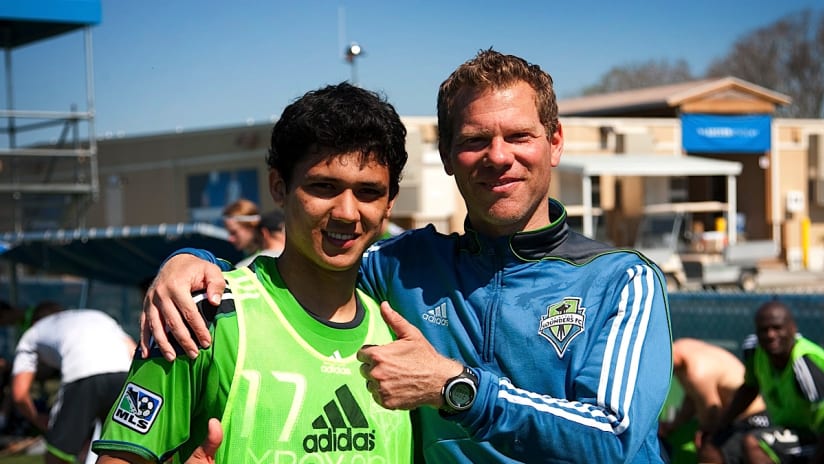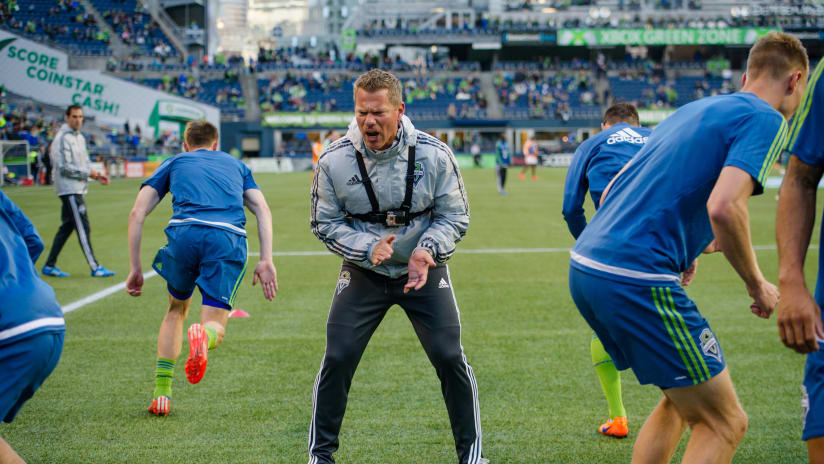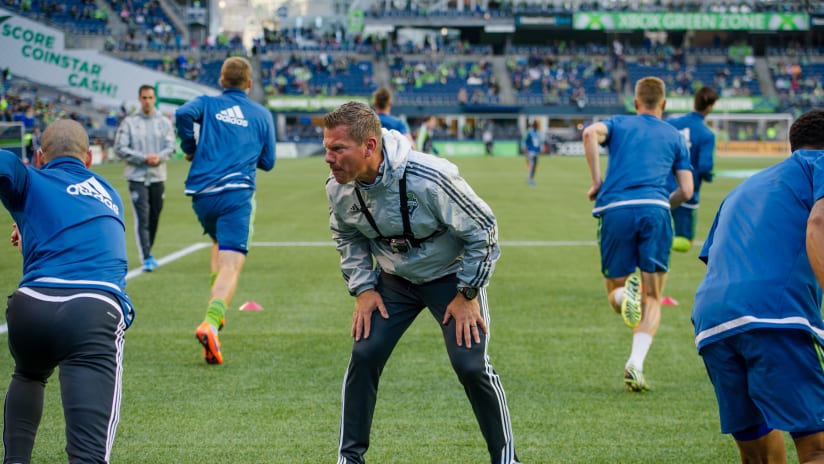Sounders FC fitness coach David Tenney travels far and wide to stay on the cutting edge of the field of sports science.
Late in the 2011 season, the Sounders FC embarked on a 10-day whirlwind tour of the CONCACAF region, playing four games in three countries in three different competitions.
They started with a drive up to Vancouver to face the Whitecaps, where they won the Cascadia Cup with a 3-1 victory. Next, they faced Comunicaciones in Guatemala City, getting two goals from Osvaldo Alonso at the end of each half to post a 2-2 draw and advance the Sounders to the quarterfinals of the CONCACAF Champions League. Then came a trip to New England, where they topped the Revolution 2-1 for their first win at Gillette Stadium. Finally, they flew back across the country to Seattle and a 2-0 win over the Chicago Fire, capping off the over 9,000 miles of travel by hoisting the US Open Cup for a third straight year.
Navigating that treacherous terrain meant a steady rotation of players were used by head coach Sigi Schmid, but also a lot was asked of key players to keep momentum for the Sounders in a stretch that saw the club go 3-0-1 in important matches.
20 players were used, 19 of them as starters. Five played in all four matches, with three – Kasey Keller, Alvaro Fernandez and Fredy Montero – starting all four.
It was a testament to the work put in by the team under the tutelage of fitness coach David Tenney.
“It’s a different type of cycle and he did a lot of research to get the best out of the team,” Sounders FC head coach Sigi Schmid said. “With a mixture of squad rotation and getting the proper rest and workload, we did a good job of making sure our team was sharp.”
That stretch of matches was just one example of the efforts of Tenney and the Sounders coaching staff balancing the need for performance with rest and recovery over a difficult stretch of match congestion for a club that was heavily active in three separate competitions, playing 48 matches in the 2011 season.
The task of the fitness coach is just that – strike the balance between rest and activity while also contending with head coaches and players who want to be on the field 90 minutes whenever possible.
It is finding new ways to strike that balance that had Tenney travelling to Holland and Belgium this month to consult with coaches in similar positions at SC Heerenveen, FC Groningen, Ajax, Utrecht and AZ Alkmaar in Holland and K Beerschot AC in Belgium.
“We all deal with the same issues and when I go to places like Holland or Belgium, they are innovative in their approaches,” said Tenney, who worked previously with George Mason University and the Kansas City Wizards. “I was interested in the technology the teams were using. Having more technology is only useful if you know how to use it.”
Through the years, Tenney has become something of a czar to the world of sports science. He was an exercise science major at Virginia Tech where he played goalkeeper before embarking on a professional career that took him to Germany to play for SV Linx and FC Rastatt. He returned stateside and played for the Washington Warthogs in the CISL, the Baltimore Blast in the NPSL and the Baton Rouge Bombers in the EISL.
When his playing days were over, he went to George Mason in Fairfax, Virginia, where he finished his degree while working as an assistant coach specializing in fitness for both the men’s and women’s soccer teams. His interest in the field was heightened by a trip to the Czech Republic to earn his A Coaching License. From Mason, he went to Kansas City, where he quickly garnered a reputation as one of the best in the business.
He came to Seattle under the strong recommendation of current Everton fitness coach Dave Tashjian, who worked under Schmid with the Columbus Crew.
“Whenever you’re going to hire a coach, you want to hire the best coach you can,” Schmid said. “Dave is very current. Fitness is probably an aspect of the game of soccer that has changed the most over the last ten years. There are more and more informational sources that you can use and he knows what’s available and what the benefits are.”
Staying current isn’t simply a matter of knowing which technology to use, but also having an intimate knowledge of how to read and gauge those outputs to maximize each individual player’s fitness while also maintaining a strong level within the team as a group and modifying training sessions to adjust accordingly.
For all the technology, most decisions still are determined by what a coach sees with the well-trained eye. The key for the programs Tenney uses, though, is catching things before they can be seen clearly on the field.
“We’ve seen hundreds of players and have feels for situations. Many of the times, the data is representative of what Sigi sees,” Tenney said. “There are times though with fatigue and injury risk, by the time you see it, it might be too late.”
That process is an ever-changing evolution.
One on which Tenney has worked tirelessly to stay ahead of the curve.




